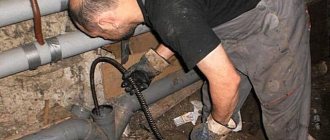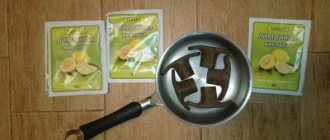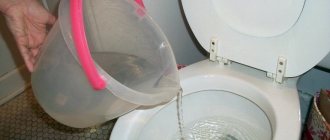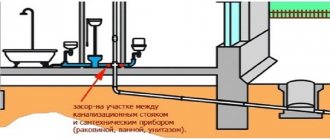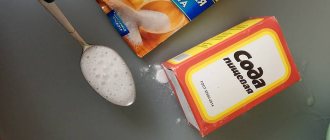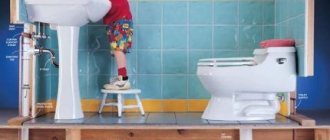Among the many options, hydrochloric acid for sewer cleaning stands out for its radical and harsh mode of action. Typically, this method is used in extreme cases when other means have not helped. Supporters and opponents of this method have endless debates about the advisability of such experiments.
The main arguments of the parties contradict each other, and reality does not confirm either one or the other argument. However, the correct application of this method can solve emerging problems. Let's take a closer look at the technology of such sewer cleaning.
Causes of blockages
The sewer system moves wastewater with a high content of organic matter and fats. They stick to the walls in a thin layer, which gradually grows and turns into a full-fledged blockage. As a rule, it is located near the drain hole of kitchen sinks or other plumbing fixtures. Most often, the siphon suffers from fat deposits, the bend of which actively collects sticky and viscous components of wastewater.
In addition, a common cause is foreign objects falling into the sewer. There may be hair, paper, construction waste (sand, residues of adhesive solutions), feminine pads and other unwanted components. They get stuck in bends or narrowing areas of the pipes, causing permanent blockages. No methods other than mechanical cleaning give results.
On cast iron pipes, there are cases of scale detachment from the inner surface of the walls. It remains inside and quickly becomes overgrown with fat, trapping small particles of organic matter. Mechanical cleaning of pipes will also be a solution to the problem.
Classification of chemicals
The choice of product depends on the type of contamination. The nature of the blockage in the bathroom, in the kitchen sink and in the toilet is different, so one drug may not be effective.
Types of chemicals:
- Alkaline - powerful reagents for combating grease and soap scum. Sediments gradually linger on the inner walls of the pipes, forming dense build-ups and a sticky film that impede the normal drainage of water and the movement of large debris and food waste. Alkali completely corrodes plaque and slippery sediment.
- Acidic ones are the best means for cleaning sewer drains. To remove severe blockages, chemicals are used together with a mechanical method. The acidic solution breaks down debris in less contaminated areas, clearing the passage for plumbing cables.
Remedies
The most effective methods include mechanical cleaning. It is simple and easy to do yourself. A plumbing cable is used, which is inserted into the pipe and pushed inside with rotational movements.
When contact with the blockage occurs, the cable tip destroys the plug. After this, the internal cavity of the pipelines is washed with a strong stream of water.
There is hydrodynamic cleaning. It is produced using special equipment. The essence of the method is to immerse a thin hose with a special tip, from which a stream of water shoots out under strong pressure. The effectiveness of this method is higher than that of alternative types of cleaning.
The use of chemicals, as a rule, is carried out only to clean the internal areas of the system. There are many formulations on sale that contain alkaline or acidic components. Sometimes drain cleaning with hydrochloric acid is used. This is an extremely dubious and dangerous method that can do more harm than good.
Using regular salt and soda
If there are no means at hand, salt is often used to clean the drain. It is poured generously into the drain hole and left for some time. Salt eats away fat deposits and makes them loose. After some time, the siphon is washed with a strong stream of water, removing organic particles.
To enhance the effect, make a mixture of soda and salt. The proportions vary, but the effect is usually the same. Please note that regular baking soda is not suitable. You need a caustic that can effectively interact with fats. In addition, caustic soda can dissolve more complex blockages. For example, hair that does not interact well with most chemicals.
However, this method is only suitable for blockages located near the drain. If the problem section of the pipe is further away, more radical remedies are needed.
Cleaning with improvised and folk remedies
To clean a toilet, sink or shower tray from plaque, you don’t have to run to the store and spend money on expensive chemicals. In addition, effective substances are expensive, and you don’t want to spend money on ineffective ones. In order to save yourself from unnecessary waste, and the toilet from limescale and urinary stone, you can use improvised means that any housewife always has in her arsenal. So, several methods of cleaning plumbing borrowed from the people.
Application of hydrochloric acid
Hydrochloric acid is a reliable fat solvent. At the same time, it is a dangerous and aggressive chemical composition. It can cause considerable harm to pipelines and people cleaning them.
Many users doubt whether it is possible to clean drains with hydrochloric acid. Their fears are quite reasonable:
- the composition is capable of corroding cast iron pipes. For residents of apartment buildings, this is a very real danger, since almost everywhere in the basement the sewage system is cast iron;
- acid vapors have a negative effect on the organs of vision, breathing, and human skin. The use of protective equipment and enhanced ventilation of the room is required;
- Cleaning the sewer with acid is done blindly. The apartment owner simply pours a large amount of acid into the drain hole and waits for the result. It cannot influence in any way the quality or efficiency of the process;
- Instead of cleaning and removing the blockage, you may end up with leaks in the cast iron parts of the system, which will require serious repairs. However, the original problem will remain.
Some sources recommend using hydrochloric acid with a concentration of no more than 3-10%. In their opinion, this will help protect cast iron pipes from contact with aggressive chemicals. However, it is clearly not possible to dissolve fat deposits from many years ago in this way.
Important
There is one more important point. Acid is poured into the plumbing drain hole. If there is water in the siphon, the concentration will drop sharply and the expected result will not be obtained. If you remove water before flushing the sewer with hydrochloric acid, the composition will only pass through the lower part of the pipelines. There will be no impact on the top of the pipe lumen. It is unrealistic to pour such an amount of chemical into the system to completely cover the section. This raises doubts about the effectiveness of the technique.
Proponents of sewer cleaning using similar methods proceed from general ideas about the properties of materials. They do not take into account the multiple factors that reduce the effectiveness of the composition. Hydrochloric acid for drain cleaning gives the desired effect only at a fairly high concentration. However, the density of the solution is difficult to maintain in the desired state. Residual water in the pipes significantly reduces the concentration of the composition. The only component of the system that receives fairly complete contact with the acid is the siphon.
However, it is easier to disassemble and perform mechanical cleaning. It will take much less time and will not require noticeable effort.
You may also like:
How to clean the drain and remove the blockage with your own hands
Cleaning sewer wells: methods and techniques
How to choose the right drain cleaner
The first thing you should pay attention to is the form of release of the drug. Gels have the lowest consumption and the greatest efficiency.
They do a good job of removing grease plugs and removing plaque on the inner surface of the pipe; their thick texture helps them penetrate through the water column, even when the bathtub or sink is full, and reach the spot in the shortest possible time.
If you suspect that the clog consists of clumps of hair or pet hair, then it is better to give preference to powders or granules. The exposure time in this case may be a little longer, but the cork will completely dissolve.
When choosing a chemical, you should pay attention to the manufacturer's recommendations. The packaging may contain a note for which pipes this composition is best suited for: in the kitchen or in the bathroom. In the first case, inside the pipe, for the most part, there are fat deposits that are effectively dissolved by alkali.
For use in the bathroom, it is better to give preference to products based on acids and chlorine.
Step-by-step instruction
Before cleaning the drain with hydrochloric acid, it is necessary to prepare personal protective equipment. In addition, it is necessary to organize enhanced ventilation of the room. Procedure:
- pour a chemical composition into the drain hole. Hydrochloric acid is fed into the sewer carefully, in a thin stream, so as not to splash around. It should be enough for the solution to travel as far as possible through the pipe;
- stand for a certain time. We recommend covering the drain hole with a lid, rag or other object. The composition should be kept for as long as possible and for at least half an hour;
- release a strong stream of water and rinse the pipe cavity well.
Sometimes sulfuric acid is used instead of hydrochloric acid to clean drains. Cleaning the system in this way is even more dangerous, since sulfuric acid vapors are highly concentrated. In addition, it is effective only in high concentrations, which makes its use unreasonably dangerous.
Precautionary measures
Since the reagent has a strong corrosive ability and releases toxic fumes when interacting with air, it is very important to use protective equipment when working with it.
When contacted with the skin and mucous membranes, the material causes chemical burns, and with prolonged exposure to an HCl atmosphere, tooth decay occurs, catarrh of the respiratory tract develops, and ulceration of the nasal mucosa occurs.
For protection purposes, it is necessary to use a gas mask, a rubberized apron, goggles and rubber gloves. Carry out work only in well-ventilated areas. If the reagent gets on your skin or mucous membranes, rinse the affected area with plenty of running water and seek medical help.
Conclusion
If precautions and safety rules are observed, hydrochloric acid will become an indispensable assistant in everyday life. And you can purchase it at the most affordable prices in our company.
For example, there are 20 liter glass bottles in which acid was stored. Is it possible to wash it so that the wine can then sit in this container?
Trust a chemist with 50 years of experience. Glass containers containing inorganic acids (sulfuric, nitric, hydrochloric, phosphoric, as well as organic - acetic or formic) can be washed simply with water. To do this, it is not at all necessary, as some here advise, to completely fill them with water; you don’t even need a pack of salt. For example, it is enough to rinse a 20-liter bottle two or three times with 2-3 liters of water, i.e. in total you will need about 6-10 liters of water. To be on the safe side, during the second rinse you can add 10-20 g of soda ash or baking soda. There are no acids that cannot be washed off glass. Sometimes there may be a situation that some organic substance got into a bottle with residual sulfuric or nitric acid, reacted (charred or tarred), and stuck to the walls in the form of black (brown, or other colored dirt). This is the kind of bottle you shouldn't use.
the system chose this answer as the best
6 months ago
Of course, acid containers You need to start by rinsing thoroughly with water, and then, remembering the relationship between acids and lye, simply add baking soda to the container. The acid reacts and is neutralized.
All that remains after the chemical reaction is to remove all its “consequences” by rinsing with clean water and adding cleaning agents.
Upon completion of all these manipulations, the container should be rinsed with clean warm water and allowed to drain completely.
I believe that after such cleaning, the container will be completely suitable for storing or transporting various liquids or substances, without the consequences of exposure to an acidic environment.
When I worked in a motor transport company, twenty-liter bottles of sulfuric acid were delivered to our control room. Question: How to clean glass containers from various acids? “I didn’t steam anyone at all. After the bottle ran out, the mechanic washed it with ordinary tap water and soda , rinsed it clean, and used it to stand the mash. No one died..) They also stood in line behind them, because of the convenience of the neck - it’s easy to pull on the glove.
The best gels for cleaning pipes
Our rating presents gels from different manufacturers, volumes and price categories. The gel structure usually has a thicker formula, which helps coat the pipes.
Such products are antibacterial and, in addition to cleaning, get rid of germs and unpleasant odors. Suitable for different types of pipes, incl. and for plastic ones.
In order for the product to work, it must be left for a certain amount of time, after which the pipes should be washed with plenty of water. Can be used as prophylaxis.
4 GraSS Digger-Gel
Our rating opens with the Digger-Gel pipe gel from the Russian company GraSS.
Despite the fact that the brand appeared on the market only in 2003, their products are distributed not only in Russia, but also in more than 64 countries around the world. In their own laboratory they work to create modern and high-quality products. The company produces detergents and household chemicals, auto chemicals and auto cosmetics. Digger-Gel Pipe Gel comes in plastic bottles with an attractive green design on the label.
There are 3 volume options available:
- 750 ml.
- 1000 ml.
- Canister 5 l.
The product not only gets rid of clogs, it also eliminates unpleasant odors and is antibacterial. Before use, shake the composition, then pour 300-500 ml of liquid and leave to work for 2-3 hours. After this, the pipes are washed with large quantities of hot water. The product can be used as a preventive measure.
Buyers note that the gel does not have a strong odor, copes well with small and medium-sized blockages, and does not damage pipes.
Pros:
- Eliminates odors.
- Suitable for metal and plastic pipes.
- Is antibacterial.
- Various volume options.
Minuses:
- Long wait for results.
GraSS gel for pipes Digger-Gel
3 Mr. Muscle gel
In 3rd place is Mr.
Muscle gel for cleaning pipes. This company produces various household cleaning products. The product comes in a 500 ml bottle. It is suitable for pipes made of any material, for sinks in kitchens and bathrooms. Removes blockages and eliminates unpleasant odors. The manufacturer promises a quick solution to the problem. The contents of the bottle must be filled in and left for 5 minutes; in case of severe blockages, this time must be increased. After the product has worked, the pipes are washed with hot water. For prevention, it is suggested to use the gel once a week.
The best drain cleaners
Liquid cleaning products are useful when the plug is very difficult to clean. In addition they:
- effective in the fight against fat;
- economical;
- convenient to use.
But they also have a significant disadvantage - uselessness in standing water.
Deboucher Active – universal liquid for preventing and removing blockages
Deboucher Active
A gentle product suitable for:
- metal and plastic pipes;
- cleaning plumbing;
- removing traffic jams;
- prevention.
It is produced by the Aqualon Company. The basic formula includes:
- purified water;
- sodium hydroxide;
- sodium hypochlorite.
The product removes various types of blockages:
- paper;
- hair;
- fat;
- leftover food;
- organic plugs.
It also neutralizes odors and prevents the growth of bacteria.
It's easy to use:
- pour ½ liter into the drain;
- leave for 3 hours;
- wash off.
Sometimes a longer stay of the composition in the pipes is allowed - up to 5-6 hours.
A liter bottle costs from 600-700 rubles .
Mole - a cheap liquid anti-clog agent
Mole
One of the most popular options offered by the Russian. It is effective against all types of blockages and has no chemical odors.
The product included:
- caustic alkali;
- purified water;
- sodium hydroxide;
- sodium hypochlorite.
It is very convenient to use:
- pour ¼ liter of cleaning liquid into the pipe;
- wait half an hour;
- rinse the drain under a strong stream from the tap.
A liter bottle in stores costs no more than one hundred rubles .
Deboucher (Brawler) - the best liquid assistant, according to reviews, to break through a blockage in a pipe
I like it I don't like it
Liquid cleaning products are useful when the plug is very difficult to clean. In addition they:
- effective in neutralizing fat;
- economical;
- easy to operate.
But they also have a significant disadvantage - uselessness in stagnant water.
Deboucher Active – universal liquid for preventing and removing blockages
DeboucherI like it Dislike
A gentle product suitable for:
- plastic and metal pipes;
- cleaning plumbing;
- removing traffic jams;
- prevention.
The product is produced by Firm Aqualon. It includes:
- purified water;
- sodium hydroxide;
- sodium hypochlorite.
It eliminates various types of congestion:
- paper;
- hair;
- fat;
- food;
- organic.
At the same time, it neutralizes unpleasant odors and prevents the growth of bacteria.
The product is easy to use:
- pour ½ liter into the drain;
- leave for 180 minutes;
- wash off.
Sometimes a longer stay of the composition in the sewer is allowed - up to 5-6 hours.
A liter bottle costs on average 200 rubles .
